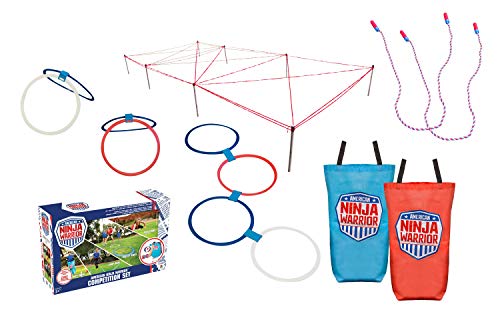Exploring Nature: 5 Outdoor Learning Activities for Preschoolers
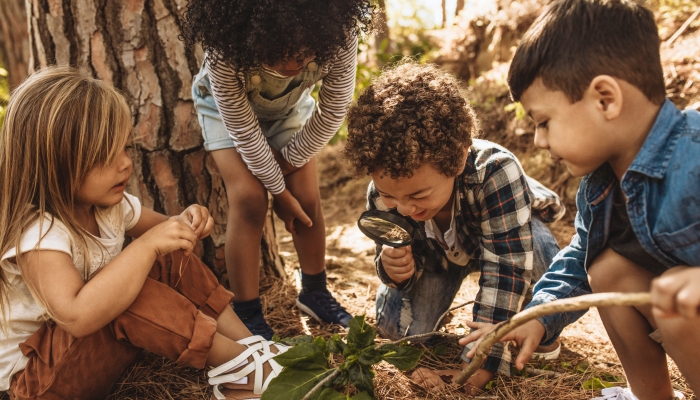
This post may contain affiliate links; please see our terms of use for details.
- Outdoor learning is fantastic fun for preschoolers while also being an important part of their mental and physical development.
- Outdoor activities for kids don’t have to be structured or formal for children to benefit from them.
- Learning outdoors can be fun for parents and children alike.
- Outdoor learning can reinforce learning your child is doing at home.
Outdoor learning offers young children many benefits. Learning through playing outside is important for preschoolers’ physical and mental health and motor skill development. It’s also linked to an increased interest in science and better learning outcomes when kids get to school.
Outdoor learning activities don’t have to be structured or formal. Preschoolers are naturally curious and learn from the natural environment organically.
However, you can encourage kids to spend more time outside with your involvement in tailored activities that are so much fun, they won’t even know they’re learning!
We’ve put together a guide to the best outdoor learning activities for preschoolers to help you spend some time together outside learning through fun hands-on experiences.
Activity 1: Outdoor Murals
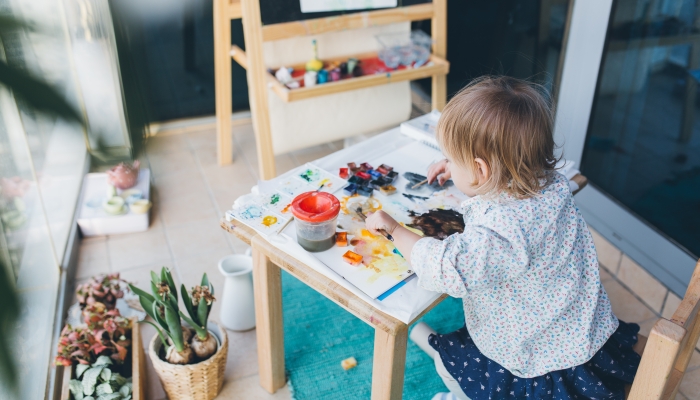
Doing art projects outside encourages creativity and imagination and exercises fine motor skills. It’s also great for working on observation skills and appreciating nature.
Outdoor art also gives your children an opportunity to engage in messy play with easier clean-up and less stress.
You Will Need:
- Large poster board, roll of butcher paper, or recycled sides of large cardboard boxes.
- Non-toxic washable poster paint or squeezy paint.
- Different-sized and shaped paint brushes and sponges.
- Bowl of clean water for rinsing.
- Have great fun painting without getting in a mess
- Jumbo tip washable brushes that contain a paint reservoir
- So kids can simply squeeze and brush with smooth, easy strokes
- Refillable 24ml tubes in assorted bright colours
Directions:
Set up your large paper on a flat, washable surface, like a patio or deck. Provide your child with paints, brushes and sponges.
There are several ways you can direct the activity:
- Let your kids paint whatever comes to mind and freestyle.
- Paint your child’s hands and feet and have them make a tree or a rainbow out of their hand and footprints. Include yours too.
- Give your kids a theme, like the solar system or zoo, and challenge them to paint a mural of it.
- Ask your child to observe the nature scene around them and paint it.
Let their creation hang to dry outside while they help you rinse off and clean up.
For extra artistic fun, hang your child’s artwork on a clothesline outside to create an outdoor art gallery to show to friends and family.
Learning Outcomes:
Art-based outdoor activities for preschoolers help build:
- Fine motor skills.
- Creativity.
- Observation.
- Color recognition.
- Sensory awareness.
- Confidence.
Activity 2: Nature Scavenger Hunt
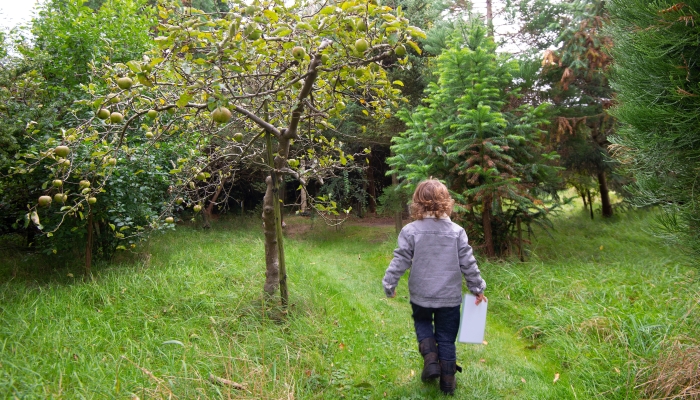
It isn’t always easy to get kids up and outside into nature. Add a scavenger hunt to make your next nature walk more interesting and fun.
This outdoor activity is excellent for improving observation, identification, and problem-solving skills. It also increases your child’s interest in nature and is a great introduction for your preschooler to science.
You Will Need:
- A list of items to find, appropriate to your environment.
- Small bags or buckets for collecting items.
- Small spades or nets to collect things with.
- Optional pencils and clipboards to check off found items.
Directions:
Come up with a list of items your child could find in the place you’re visiting. To add numeracy learning, ask them to find a certain number of things—for example, five acorns. Give your child a list and a collection bag.
For added fun, put the list on a clipboard with a pencil which makes kids feel very important.
After the hunt, sit down and go through the items and discuss their features, elements, and roles in the environment.
Learning Outcomes:
This activity is great for:
- Observation.
- Developing an interest in science and nature.
- Problem-solving.
Activity 3: Mini Gardeners
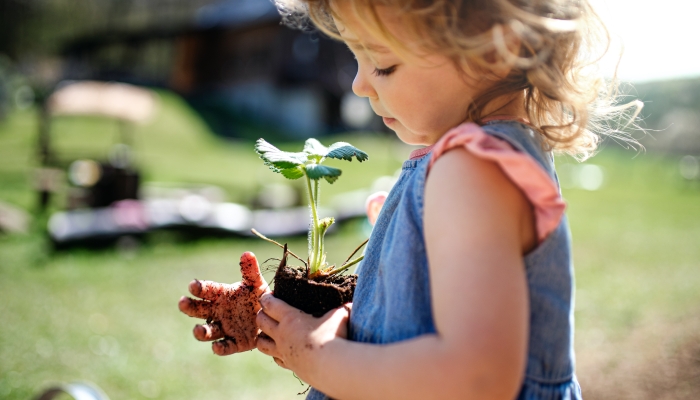
Planting seeds and watching them grow over time is one of the most valuable activities you could ever do. Children learn so much from the experience of growing and taking care of plants.
This outdoor activity helps children learn about the plant life cycle, understand where our food comes from, and practice patience. Children will work on observation and caretaking skills, as well as developing a sense of responsibility.
Don’t have a backyard or a garden? No problem! This activity can be adapted to planting seeds in pots and growing them in your kitchen or a window box.
You Will Need:
- Seeds.
- Soil.
- Plant markers.
- Kid-size gardening tools and gloves.
- Water for plants.
- Small pots or garden beds.
- Plant in style: Plant markers shouldn’t be an eyesore. Keep track of your plant or garden with these stylish T-type bamboo plant Tags. Unlike plastic tags, these are made from 100% bamboo and blend in with your plants.
- Eco-friendly: Plastic and nature don’t go together, so don’t use plastic markers for your precious plants! Made from 100% natural bamboo, a renewable resource, these plant labels are eco-friendly and help the planet.
- Perfect shape & size: Measuring in at 4″ tall x 2.15″ wide on top (1.35″ tall on the top part) these T-type garden markers provide ample space to write the name of the plant and its date without having to cram any letters. Each marker is 1/16″ thick rendering them very durable and standing the test of time.
- Super value pack: You’ll find 50 bamboo plant markers packaged neatly in a beautiful box, giving you enough markers for all your needs and more. Use as much as you need, and store the rest easily in its neat, compact box until your next planting opportunity.
- #1 EDUCATIONAL GARDENING SET: This set is great for children who LOVE GARDENING or to TEACH CHILDREN about gardening and planting.
- SPECIALIZED FOR CHILDREN: The tote bag is LIGHTWEIGHT and convenient for children to carry with themselves while gardening. The tools have rounded edges to ensure SAFETY for the kids.
- SET INCLUDES: Canvas Tote; Shovel; Rake; Fork; Watering Can; Kid-Sized Gloves; All tools are made with WOODEN handles and QUALITY METAL heads.
- PROMOTE SKILLS: Gardening out with children is a wonderful way to promote their IMAGINATION and PHYSICAL ACTIVITY. Great for Parent/Child relationships.
Directions:
Follow the seed packet instructions for the best location, soil, and time of year to plant.
Have your child help you dig holes, plant the seeds, mark them, and water them. Every few days ask your child to check on your plants to see if there’s been any change and make sure they’re watered.
As your plants grow, chart their progress in a gardening journal or on a chart to enhance writing and observation skills. Discuss the life cycle of a plant and ask your child to predict what will happen.
If you don’t have a lot of time or space to observe your plants or want something that’s faster growing for younger children, try planting seedlings in pots rather than starting with seeds. Plant a bean in a pot in your kitchen. Look for fast-growing giant sunflowers and strawberry plants for quicker results.
Learning Outcomes:
Gardening helps kids with:
- Connecting with nature.
- Developing interest in science.
- Learning to follow a process.
- Developing patience and responsibility.
- Learning to record observations.
Activity 4: Backyard Obstacle Course
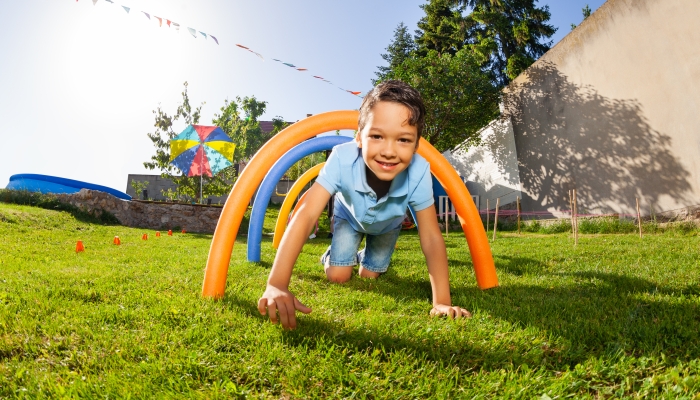
A homemade obstacle course is a fun way of getting your kids outside and working on those gross motor skills.
Add some STEM learning by involving your kids in creating the obstacles and building the challenges.
There are readymade obstacle course kits on the market that are easy to set up. But you can make one easily with a little imagination and some household items.
- It’s time to put your ninja warrior training to the test with the American Ninja Warrior Competition Set. From head-to-head, team or timed competition, this complete 33-piece set allows for dozens of different set-ups. No matter the age or skill level, you can create a course and great family fun to match.
- The set includes diagrams for suggested course set-ups, two 30” x 20” reinforced hop sacks, eight 14” agility rings with dual use connectors, two competition jump ropes, birch wood bear crawl posts, and over 150’ of twine.
- Head-to-head, team or timed competition! Includes 2 hop sacks, 2 jump ropes, 8 agility rings with connectors, bear crawl Use the suggested course set-ups or create your own!
- Ages 3+
You Will Need:
Optional ideas for things you can use to set up your course include:
- Old pillowcases or yard clipping bags that can be used for sack jumping.
- A play tunnel to crawl through.
- A jump rope to do a certain number of jumps.
- Hula hoops to step through.
- A kiddie pool full of water with floating objects and a net for your child to fish them out.
- Cones to kick a ball around or to walk through.
- Non-slip stepping stones to balance on.
- Outdoor climbing toys that you already have.
- IMAGINARY PLAY: The play tunnel is the perfect place to take a break and explore your imagination! It bends into many fun shapes to promote creative play, and children can crawl inside to help strengthen important motor skills.
- 6 FEET LONG: This durable 6-foot-long tunnel will give preschoolers their own space for new adventures. They will have fun playing by themselves or with friends.
- ACTIVE PLAY: Active kids love to run around and play. With this tunnel, kids 3 and up will have a place to play hide and seek, freeze tag, racing and more fun games!
- BUILD PHYSICAL AND SOCIAL SKILLS: Climb into a new adventure in your own living room. This pop-up play tent is the ultimate play space for kids to enjoy year-round play.
- HEAD OUTSIDE: Kids will love Melissa & Doug 8 Activity Cones, which are ideal for outdoor group play.
- ARRAY OF COLORS: This set includes 8 fade resistant cones, in 4 colors and 2 textures. Colors include blue, orange, red, and yellow.
- ACTIVE PLAY: These versatile cones are ideal for working on balance, counting, colors, water play, sports, and more Instructions to dozens of games are included.
- GREAT GIFT FOR AGES 3 TO 6: Melissa & Doug 8 Activity Cones is an ideal gift for kids ages 3 to 6. Add a Giddy Buggy Tunnel to round out the hands-on, screen-free play experience.
- 6 DURABLE, NON-SLIP STONES – Includes 6 durable plastic stepping stones in 6 bright colors! Perfect for kids 3+ and up to 150 lbs., they can be used indoors or for kids outdoor play. These active sensory toys promote coordination skills & balance!
- DESIGNED FOR MAXIMUM SAFETY – Each stone has a non-slip rubber base and textured stepping surface for enhanced safety. Kids can focus on their balance and coordination as they safely jump from stone to stone and navigate their obstacle course.
- RUGGED, STACKABLE DESIGN – A rugged design makes these stones ideal for both indoor and outdoor use. They also stack easily for storage or transport, so they can be used at home, the park, daycare, or anywhere else kids enjoy active play!
- SPINNER GAME INCLUDED – Kids can use the included spinner to create fun games with their stepping stones! Just set them up in a challenging configuration, spin the dial, and jump to the color it lands on for an imaginative, active style of play!
Directions:
Have your kids help you set up a course in your backyard or an open space in the park. Challenge your kids to come up with as many creative ideas for your course as they can. If they find materials outside they’d like to use, like sticks or rocks, find a safe way to use these.
Once your course is set up, help your kids get through it. You can encourage them to go fast and time it, but you can also just let them try to complete it. Make sure you take a turn too!
Learning Outcomes:
This physical activity will help your kids with:
- Gross motor skills.
- Hand-eye coordination.
- Following instructions and a sequence of events.
Activity 5: Outside Writing Practice
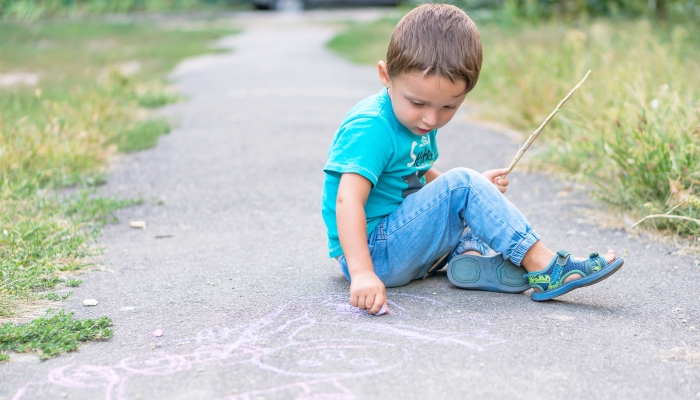
While establishing the correct pencil grip is important, sitting down at a desk to practice writing is not the only way to work on this fine motor skill. You can reinforce letter and number recognition and support early writing with outdoor activities.
You Will Need:
Optional materials you can use to practice writing outside include:
- Shaving cream.
- Sidewalk chalk.
- Natural materials like sticks, rocks, or leaves.
- Spray bottle filled with water.
- Flat, hard surface outside.
Directions:
Try these different ways of writing your child’s name or practicing their letters:
- Challenge your child to write their name in shaving cream on the patio, or, alternatively, create a flat surface of shaving cream and let kids trace their name in it.
- Give your child a letter and ask them to draw a picture of something starting with that letter with sidewalk chalk in your driveway.
- Get your kids to gather up some sticks, stones, and leaves and work together to spell their name or make the shape of a letter out of those materials.
- On a dry day, take a spray bottle with water and help your child spray the shapes of letters on the ground.
There are so many ways to organically encourage your child to practice writing outside, like tracing letters with sticks in the mud. Look out for those opportunities whenever you’re outdoors.
Learning Outcomes:
Outdoor writing activities are excellent for:
- Fine and gross motor skills.
- Literacy practice.
- Creativity.
- Communication.
Parental Involvement in Outdoor Learning
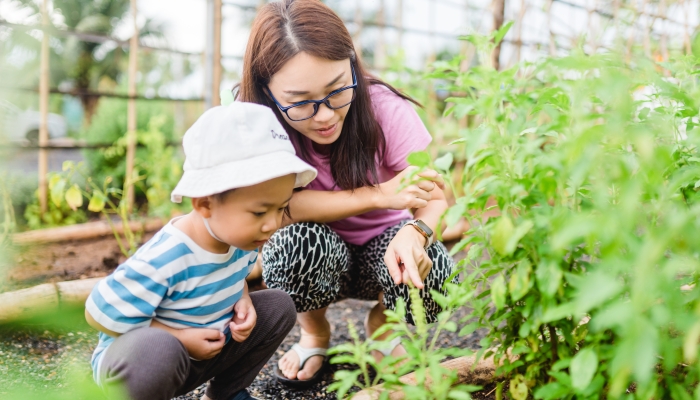
A recent study11. Bento, G., & Dias, G.. The importance of outdoor play for young children’s Healthy Development. Porto Biomedical Journal. 2017;2(5), 157–160. https://doi.org/10.1016/j.pbj.2017.03.003 published in the Porto Biomedical Journal suggests that outdoor play is linked to better academic achievement and better mental and physical health.
However, outdoor activities are also an excellent way to bond with your child, create memories, and spend quality time together.
Use Outdoor Play to Reinforce Learning
Kids love their parents’ and caregivers’ involvement in their activities, and outdoor learning in the fresh air is a fun way to reinforce the learning they’re doing at home.
For example, if you’re trying to practice letter recognition with your child, getting away from workbooks and pencils for a while to write letters in shaving cream outside can really boost their skills and help them remember the concept in a new way. It’s also a fun boost for everyone’s mood!
Things for Parents to Remember for Outdoor Learning
We know that outdoor activities for kids are great for their learning and good for your family relationships too. However, there’s nothing worse than doing something fun outside, only to realize you’re not prepared for the elements or an emergency.
Here are some things to remember for safe outdoor learning fun:
| Check the weather, and bring appropriate clothing and shoes |
|
| Know the area you’re playing in, and supervise and create boundaries. |
|
| Be prepared for any emergency. |
|
References
- Bento, G., & Dias, G. (2017). The importance of outdoor play for young children’s Healthy Development. Porto Biomedical Journal, 2(5), 157–160. https://doi.org/10.1016/j.pbj.2017.03.003
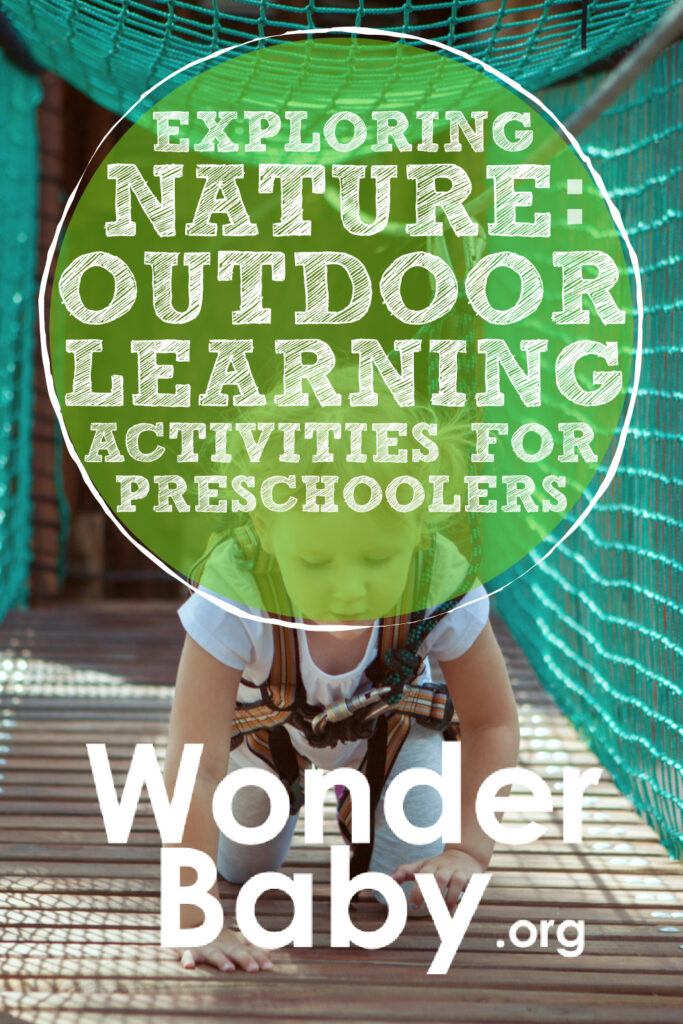
Related Posts
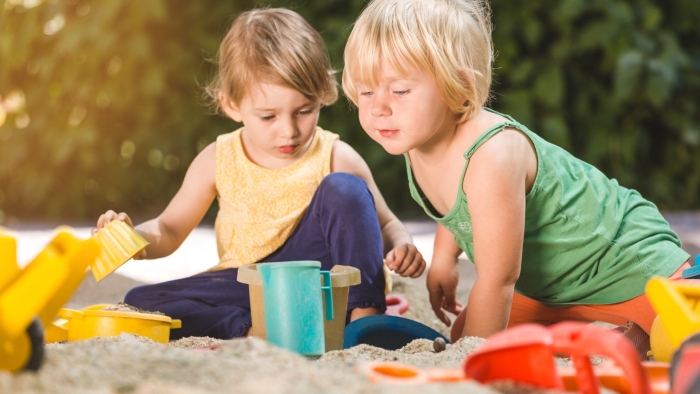
Sensory Activities
5 Sand Play Activities to Encourage Fine Motor Development
Sensory bin, at the beach, or in a sandpit? Try these sand play activities to help toddlers and preschoolers develop their fine motor skills.
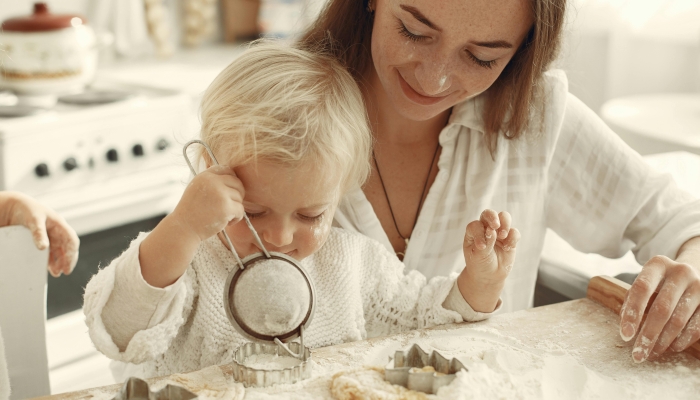
Sensory Activities
5 Edible Sensory Play Ideas
Check out our favorite edible sensory play activities to engage children's senses, boost their development, and provide hours of fun.
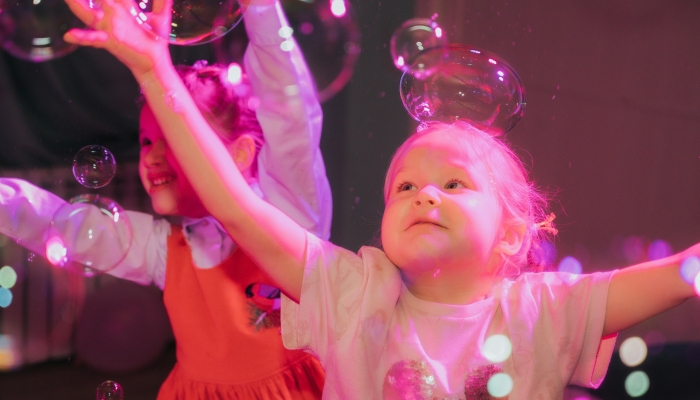
Sensory Activities
How to Make Unpoppable Bubbles
Discover the secret to making unpoppable bubbles with this easy guide. You only need three ingredients!



